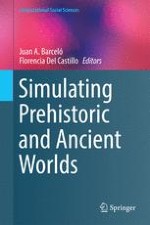
2016 | OriginalPaper | Chapter
1. Simulating the Past for Understanding the Present. A Critical Review
Authors : Juan A. Barceló, Florencia Del Castillo
Published in: Simulating Prehistoric and Ancient Worlds
Publisher: Springer International Publishing
Activate our intelligent search to find suitable subject content or patents.
Select sections of text to find matching patents with Artificial Intelligence. powered by
Select sections of text to find additional relevant content using AI-assisted search. powered by